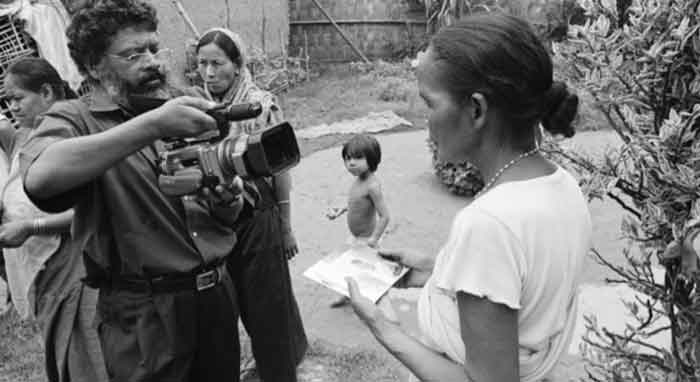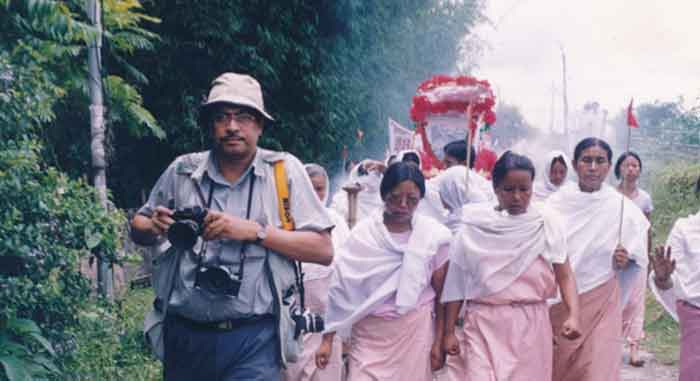
I started photographing rickshaw pullers in Manipur, who veil their faces so as not to disclose their identity as a rickshaw puller, even to their fiancé. Because they consider plying rickshaw is a low profile job. Now it has become a routine practice in Manipur, veiling the faces.
My documentation of the rickshaw pullers in Imphal, the capital city of Manipur was the impact of the award winning filmmaker and writer Joshy Joseph’s documentary film ‘ Wearing the Face’ on the same rickshaw pullers. In fact Joshy introduced me to Manipur, I mean ‘political’ Manipur.
Likewise the shy guy Razak was introduced to me in Imphal, as far I remember in 2004 when Joshy started shooting for a new documentary film and Razak was the cameraman.

Earlier, Razak had never any experience as a cinematographer. Joshy picked up him as his cameraman realizing Razak’s intensity of aesthetic sense and political sensitivity.
Razak worked with Joshy as a cinematographer for so many documentary films and notably ‘ Making the Face’ shot in Manipur fetched National Award.
He is known as a photographer who worked with Adoor Gopalkrishnan for a long time. He took pictures of the eminent litterateurs and noted cultural personalities of Kerala. He used to write regularly in Mathrubhumi magazine related to the photographs taken by him.

I took some of photographs of Razak, particularly in Manipur with the intention of developing a project, where cinematic frames of Razak conflict and blend with my photographs while both of us shooting in Manipur, he for Joshy’s films and me as an intrusive photographer in the political context of Manipur.
But, the project couldn’t be developed as Razak passed away untimely….
In Calicut, a group of people took the initiative to form Razak Kottakal Memorial Foundation.
They organized his exhibition at Lalit Kala and it was a great honor for me to inaugurate the exhibition, launching his book and sharing the dais with Raghu Rai, Adoor Gopalkrishnan and other personalities.
One thing has to be mentioned that Joshy and I decided Razak to shoot as a cinematographer for my film on the legendary photographer Raghu Rai. But at that time Razak was in a chaotic state of mind. There was a dichotomy in Razak’s personal life. He was most unorganized as human behavioral practices are concerned. But, he was having so mindful thoughts and amazingly organized while shooting, either with a still camera or a video camera.
The film ‘Raghu Rai: Hearing Through The Eyes’ was screened as a part of the memorial programme, where we missed Razak in the film as a cinematographer and as well as an audience.
About Razak’s photographs:
Razak showed me the photographs of Adoor Gopalkrishnan, when he was in Kolkata. After seeing the photographs I got excited and tried at my level best to put up an exhibition in this city. But, unfortunately it didn’t happen.
But I am really happy to see his photographs being finally published by the Foundation in his name and unvelied by Raghu Rai in the presence of Adoor Goplakrishnan.
I knew Razak as a photographer working with and on Adoor. But while seeing the exhibition I found Razak at a different level. The transition from black and white to the colour is a journey of forms, breaking the streotypes and going beyond the so called photojournalism.
Not only does his work carry a strong sense of composition, form, and geometry but they also carry an emotional impact. His photos are raw, gritty, and show both the hope and melancholy of life.
There’s more to photography than f-stops and photoshop. Something big. I’m talking about the creative vision piece, what I call ‘The Art of Seeing and Imagination’. After studying Razak’s photographs I started feeling that the mighty internet feels like a ghost town when it comes to practical ways for photographers to sharpen their creative vision.
Too often people with some talent go where there is some money to be made. They begin to trade a bit of their talent for a bit of money, then a little more, and finally they have nothing left to them.
Razak was a man who made photography the priority of his life. He sacrificed a lot, as he never had the best family life and never spent a lot of time in one place. He was like a nomad. He valued his freedom above everything else, and took his photography and cinematography as well very seriously.
At the end of the day, he didn’t pursue his photography for money, fame, or to impress others. He photographed for the love of it, and for himself.
Creativity was a muscle of Razak, who was able to teach anyone the Photographer’s Eye.
But the language barrier couldn’t make him to go beyond Kerala.
As a tribute, I am committed to bring him out of Kerala.
Suvendu Chatterjee is a photographer and curator
SIGN UP FOR COUNTERCURRENTS DAILY NEWSLETTER













































